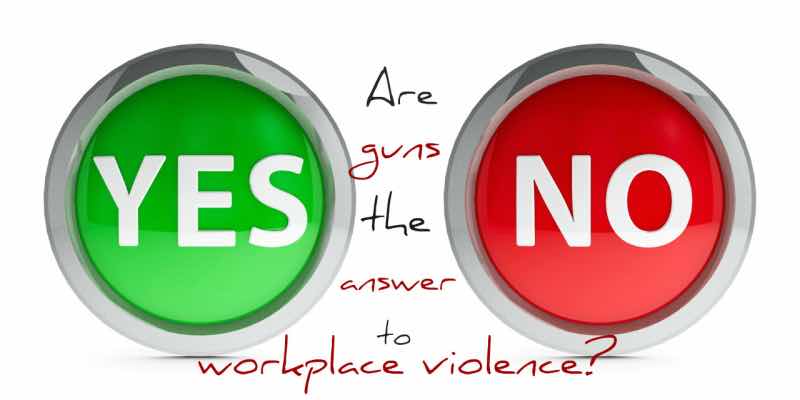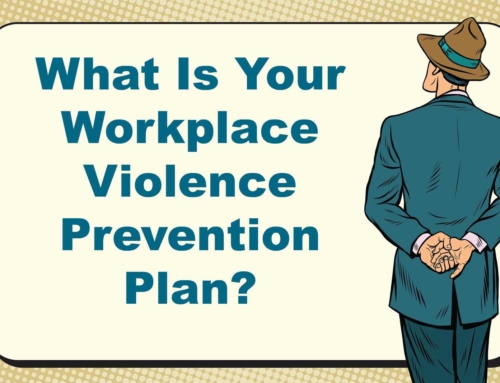Are Guns The Answer to Workplace Violence?
There is a recent movement which advocates training employees to use their own firearms in the workplace when an active shooter arrives and starts firing.
The premise is this: When the shooter reaches your workplace and begins to empty their weapon of loaded ammunition, employees who are already armed themselves become the best possible response in order to deal with the active shooter rather than waiting for the local police department to turn up at the front door.
I certainly understand the philosophy.
It considers the fact that the delay caused by the logical and necessary sequence of events when calling 911 (finding a safe phone to call from, dialing 911, having the call answered by the police dispatcher, the dispatcher listening to you, understanding the gravity of the situation, communicating the situation to the patrolling officers, time for the officers to understand and process the information, the officers driving to your workplace, and finally entering the workplace to locate the shooter) ALL TAKES TIME: time in which the active shooter may have shot more victims.
I understand that.
What I disagree with is that the presence of employees who are armed provides for a safer workplace.
Someone once said, “Guns don’t kill people. It is the person holding the gun that kills people.”
Four Distinct Sources of Workplace Violence
When you examine workplace violence statistics, no matter where you are in the world, you see that there are four distinct sources of workplace violence.
- The stranger who has absolutely no connection with your workplace
- The Co-Worker or Supervisor
- The Customer or Client
- A person in an intimate partner relationship with someone at the workplace
Although I do not have the exact statistics at hand, I would strongly suggest to you that the primary source of an active shooter in a workplace (a person who turns up at the front door with a loaded weapon, bent on destruction) is NOT going to be a random stranger, who has absolutely no connection with the workplace.
The active shooter is going to be in one of the other three categories.
Warning Signs
Which means that there will be warning signs.
If these warning signs are interpreted correctly (and shared with those in the workplace who have a legal obligation to keep employees safe when they are at work) they should be used to prepare the workplace well in advance of any shadow falling on the front door.
I have always advocated – and I do so again here – that there is a tried and tested process for preparing an organization against a potential act of workplace violence. It is one that is strongly advocated through federal and local safety regulatory bodies.
It many jurisdictions, this ‘process’ is an employer’s legal obligation.
It starts with senior management commitment and moves through policies, risk assessments, plans, training, exercising and drills. It is designed to change the very culture of a workplace where each person looks out for everyone else. So, when someone becomes aware of a potential risk – not just to themselves, but to everyone – that they alert the workplace through a recognized process in order for action to be taken. It is not one person’s job. It is the entire organization’s job.
There is no system which will guarantee a Fort Knox-level of security.
It is my strong belief that the prospect of armed employees, poised and ready to strike, increases the potential for workplace violence, rather than diminishes it.
Pay attention to the warning signs and act rather than arming the person next to you.
These are my thoughts – a 35-year veteran police officer who also just happens to be an expert in the field of workplace violence prevention.
What to do in the case of an “Active Shooting”
By the time police arrive on scene to an active shooter incident, many times it is too late.
In light of this, employees should be educated on how to respond to an active shooter incident as it unfolds. This is the same education that many institutions, universities and schools have built into their emergency response plans.
Experts on multiple levels advise those who are caught in an incident or other violent situation to recall three response priorities:
- Run: If employees are able, their first reaction should be to run to a safe location outside the building and away from the perpetrator. They should try to escort as many of their colleagues as possible. Then call 911.
- Hide: If exiting the building is impossible, employees should hide — seeking shelter in an enclosed room and barricading the door. Keep quiet and silence mobile phones.
- Fight: Only as a last resort, employees should be prepared to try to take down the perpetrator to save lives, using anything available — phones, laptops, fire extinguishers, trash cans, chairs — as self-defence weapons.
As soon as possible, employees should call 911 and request or provide prompt medical evaluation and treatment to affected individuals. The emphasis is on the physical and emotional well being of the people involved.







Leave A Comment